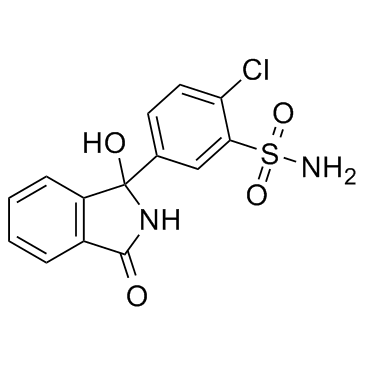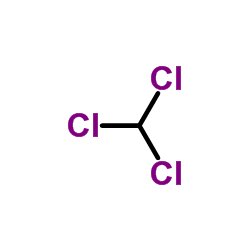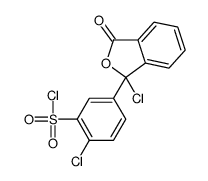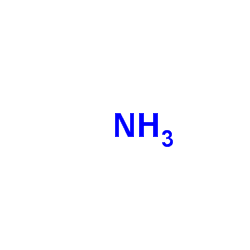77-36-1
| 中文名 | 氯噻酮 |
|---|---|
| 英文名 | chlorthalidone |
| 中文别名 | 氯塞酮 |
| 英文别名 |
2-Chloro-5-(3-hydroxy-1-oxoisoindolin-3-yl)benzenesulfonamide
Higroton (±)-Chlorthalidone Chlorthalidone 2-chloro-5-(1-hydroxy-3-oxo-2H-isoindol-1-yl)benzenesulfonamide MFCD00036257 2-Chloro-5-(1-hydroxy-3-oxo-2,3-dihydro-1H-isoindol-1-yl)benzenesulfonamide chlortalidone (±)-Hygroton 2-Chloro-5-(1-hydroxy-3-oxoisoindolin-1-yl)benzenesulfonamide EINECS 201-022-5 |
| 描述 | Chlorthalidone 是一种噻嗪类利尿剂,可用于治疗高血压。 |
|---|---|
| 相关类别 | |
| 体内研究 | 氯噻酮是一种类似噻嗪类的利尿剂。口服摄入后,在2-6小时内达到峰值血清浓度。氯噻酮的半衰期约为42小时(范围29-55)小时,在长期给药后达到45-60小时。然而,氯噻酮的半衰期的个体差异很大。氯噻酮通过肾脏不变地排泄。氯噻酮的利钠作用在18小时时最大,持续超过48小时。比较不同剂量的氯噻酮,已观察到每日25毫克几乎与较高剂量一样有效,但低钾血症风险较低[1]。氯噻酮可减少草酸钙的结石复发,但氢氧化镁则不会。在预防复发的草酸钙肾结石中检查了氯噻酮或氢氧化镁的有效性。在双盲随机分配设计中,每日剂量为25或50毫克。氯噻酮,650或1,300毫克。给予氢氧化镁或相同的安慰剂。与预处理率相比,所有组显示显着减少的结石事件。在试验期间,安慰剂组发生的结石比预测的结石少56.1%(p <0.01),而接受低剂量和高剂量氢氧化镁的组分别显示73.9%和62.3%的结石(p小于0.001且小于分别为0.01)。氯噻酮治疗导致预测率下降90.1%,两种剂量均产生类似结果。当比较治疗时,氯噻酮明显优于安慰剂或氢氧化镁(p小于0.01)。当给予安慰剂或无效治疗时,观察到的结石事件的大量减少强调了当使用历史对照时发生的积极治疗偏差并且他们证明需要适当的实验设计[2]。 |
| 参考文献 |
| 密度 | 1.6±0.1 g/cm3 |
|---|---|
| 熔点 | 265-267ºC (dec.) |
| 分子式 | C14H11ClN2O4S |
| 分子量 | 338.766 |
| 精确质量 | 338.012817 |
| PSA | 117.87000 |
| LogP | -0.74 |
| 外观性状 | 白色至淡黄色-白色结晶粉末无气味的 |
| 折射率 | 1.694 |
| 储存条件 | 本品应密封阴凉保存。 |
| 水溶解性 | DMSO: soluble5mg/mL, clear (warmed) |
| 分子结构 | 1、 摩尔折射率:81.24 2、 摩尔体积(m3/mol):211.5 3、 等张比容(90.2K):617.7 4、 表面张力(dyne/cm):72.7 5、 极化率(10 -24cm 3):32.20 |
| 计算化学 | 1.疏水参数计算参考值(XlogP):0.9 2.氢键供体数量:3 3.氢键受体数量:5 4.可旋转化学键数量:2 5.互变异构体数量:2 6.拓扑分子极性表面积118 7.重原子数量:22 8.表面电荷:0 9.复杂度:564 10.同位素原子数量:0 11.确定原子立构中心数量:0 12.不确定原子立构中心数量:1 13.确定化学键立构中心数量:0 14.不确定化学键立构中心数量:0 15.共价键单元数量:1 |
| 更多 | 1. 性状:白色结晶性粉末。 2. 密度(g/mL,25/4℃):不确定 3. 相对蒸汽密度(g/mL,空气=1):不确定 4. 熔点(ºC)::224-226℃ 5. 沸点(ºC,常压):不确定 6. 沸点(ºC,5.2kPa):不确定 7. 折射率:不确定 8. 闪点(ºC):不确定 9. 比旋光度(º):不确定 10. 自燃点或引燃温度(ºC):不确定 11. 蒸气压(kPa,25ºC):不确定 12. 饱和蒸气压(kPa,60ºC):不确定 13. 燃烧热(KJ/mol):不确定 14. 临界温度(ºC):不确定 15. 临界压力(KPa):不确定 16. 油水(辛醇/水)分配系数的对数值:不确定 17. 爆炸上限(%,V/V):不确定 18. 爆炸下限(%,V/V):不确定 19. 溶解性:在氢氧化碱金属液中易溶,甲醇中溶解,乙醇和氯仿中略溶,乙醚中微溶,水中几乎不溶。 |
|
Section1. IDENTIFICATION OF THE SUBSTANCE/MIXTURE Product identifiers Product name: Chlorthalidone CAS-No.: 77-36-1 Relevant identified uses of the substance or mixture and uses advised against Identified uses: Laboratory chemicals, Manufacture of substances Section2. HAZARDS IDENTIFICATION Classification of the substance or mixture Classification according to Regulation (EC) No 1272/2008 [EU-GHS/CLP] Eye irritation (Category 2) This substance is not classified as dangerous according to Directive 67/548/EEC. Label elements Labelling according Regulation (EC) No 1272/2008 [CLP] Pictogram Signal wordWarning Hazard statement(s) H319Causes serious eye irritation. Precautionary statement(s) P305 + P351 + P338IF IN EYES: Rinse cautiously with water for several minutes. Remove contact lenses, if present and easy to do. Continue rinsing. Supplemental Hazardnone Statements Other hazards - none Section3. COMPOSITION/INFORMATION ON INGREDIENTS Substances Formula: C14H11ClN2O4S Molecular Weight: 338,77 g/mol Section4. FIRST AID MEASURES Description of first aid measures General advice Consult a physician. Show this safety data sheet to the doctor in attendance. If inhaled If breathed in, move person into fresh air. If not breathing, give artificial respiration. Consult a physician. In case of skin contact Wash off with soap and plenty of water. Consult a physician. In case of eye contact Rinse thoroughly with plenty of water for at least 15 minutes and consult a physician. If swallowed Never give anything by mouth to an unconscious person. Rinse mouth with water. Consult a physician. Most important symptoms and effects, both acute and delayed Gastrointestinal disturbance, Dermatitis, Nausea, Dizziness, Headache Indication of any immediate medical attention and special treatment needed no data available Section5. FIREFIGHTING MEASURES Extinguishing media Suitable extinguishing media Use water spray, alcohol-resistant foam, dry chemical or carbon dioxide. Special hazards arising from the substance or mixture Carbon oxides, nitrogen oxides (NOx), Sulphur oxides, Hydrogen chloride gas Advice for firefighters Wear self contained breathing apparatus for fire fighting if necessary. Further information no data available Section6. ACCIDENTAL RELEASE MEASURES Personal precautions, protective equipment and emergency procedures Use personal protective equipment. Avoid dust formation. Avoid breathing vapors, mist or gas. Ensure adequate ventilation. Avoid breathing dust. Environmental precautions Do not let product enter drains. Methods and materials for containment and cleaning up Pick up and arrange disposal without creating dust. Sweep up and shovel. Keep in suitable, closed containers for disposal. Reference to other sections For disposal see section 13. Section7. HANDLING AND STORAGE Precautions for safe handling Avoid contact with skin and eyes. Avoid formation of dust and aerosols. Provide appropriate exhaust ventilation at places where dust is formed. Conditions for safe storage, including any incompatibilities Store in cool place. Keep container tightly closed in a dry and well-ventilated place. Recommended storage temperature: 2 - 8 °C Specific end uses no data available Section8. EXPOSURE CONTROLS/PERSONAL PROTECTION Control parameters Components with workplace control parameters Exposure controls Appropriate engineering controls Handle in accordance with good industrial hygiene and safety practice. Wash hands before breaks and at the end of workday. Personal protective equipment Eye/face protection Safety glasses with side-shields conforming to EN166 Use equipment for eye protection tested and approved under appropriate government standards such as NIOSH (US) or EN 166(EU). Skin protection Handle with gloves. Gloves must be inspected prior to use. Use proper glove removal technique (without touching glove's outer surface) to avoid skin contact with this product. Dispose of contaminated gloves after use in accordance with applicable laws and good laboratory practices. Wash and dry hands. The selected protective gloves have to satisfy the specifications of EU Directive 89/686/EEC and the standard EN 374 derived from it. Immersion protection Material: Nitrile rubber Minimum layer thickness: 0,11 mm Break through time: > 480 min Material tested:Dermatril® ( Z677272, Size M) Splash protection Material: Nitrile rubber Minimum layer thickness: 0,11 mm Break through time: > 30 min Material tested:Dermatril® ( Z677272, Size M) data source: KCL GmbH, D-36124 Eichenzell, phone +49 (0)6659 873000, test method: EN374 If used in solution, or mixed with other substances, and under conditions which differ from EN 374, contact the supplier of the CE approved gloves. This recommendation is advisory only and must be evaluated by an Industrial Hygienist familiar with the specific situation of anticipated use by our customers. It should not be construed as offering an approval for any specific use scenario. Body Protection impervious clothing, The type of protective equipment must be selected according to the concentration and amount of the dangerous substance at the specific workplace. Respiratory protection For nuisance exposures use type P95 (US) or type P1 (EU EN 143) particle respirator.For higher level protection use type OV/AG/P99 (US) or type ABEK-P2 (EU EN 143) respirator cartridges. Use respirators and components tested and approved under appropriate government standards such as NIOSH (US) or CEN (EU). Section9. PHYSICAL AND CHEMICAL PROPERTIES Information on basic physical and chemical properties a) AppearanceForm: solid b) Odourno data available c) Odour Thresholdno data available d) pHno data available e) Melting point/freezingno data available point f) Initial boiling point and no data available boiling range g) Flash pointno data available h) Evaporation rateno data available i) Flammability (solid, gas) no data available j) Upper/lowerno data available flammability or explosive limits k) Vapour pressureno data available l) Vapour densityno data available m) Relative densityno data available n) Water solubilityno data available o) Partition coefficient: n- log Pow: 0,85 octanol/water p) Autoignitionno data available temperature q) Decompositionno data available temperature r) Viscosityno data available s) Explosive propertiesno data available t) Oxidizing propertiesno data available Other safety information no data available Section10. STABILITY AND REACTIVITY Reactivity no data available Chemical stability no data available Possibility of hazardous reactions no data available Conditions to avoid no data available Incompatible materials Strong oxidizing agents Hazardous decomposition products Other decomposition products - no data available Section11. TOXICOLOGICAL INFORMATION Information on toxicological effects Acute toxicity LD50 Oral - rat - > 5.000 mg/kg Skin corrosion/irritation Serious eye damage/eye irritation no data available Respiratory or skin sensitization no data available Germ cell mutagenicity no data available Carcinogenicity IARC:No component of this product present at levels greater than or equal to 0.1% is identified as probable, possible or confirmed human carcinogen by IARC. Reproductive toxicity Reproductive toxicity - mouse - Oral Effects on Fertility: Post-implantation mortality (e.g., dead and/or resorbed implants per total number of implants). Reproductive toxicity - Human - male - Oral Paternal Effects: Impotence. Specific target organ toxicity - single exposure no data available Specific target organ toxicity - repeated exposure no data available Aspiration hazard no data available Potential health effects InhalationMay be harmful if inhaled. May cause respiratory tract irritation. Ingestion May be harmful if swallowed. SkinMay be harmful if absorbed through skin. May cause skin irritation. EyesCauses eye irritation. Signs and Symptoms of Exposure Gastrointestinal disturbance, Dermatitis, Nausea, Dizziness, Headache Additional Information RTECS: DB1556000 Section12. ECOLOGICAL INFORMATION Toxicity no data available Persistence and degradability no data available Bioaccumulative potential no data available Mobility in soil no data available Results of PBT and vPvB assessment no data available Other adverse effects no data available Section13. DISPOSAL CONSIDERATIONS Waste treatment methods Product Offer surplus and non-recyclable solutions to a licensed disposal company. Dissolve or mix the material with a combustible solvent and burn in a chemical incinerator equipped with an afterburner and scrubber. Contaminated packaging Dispose of as unused product. Section14. TRANSPORT INFORMATION UN number ADR/RID: -IMDG: -IATA: - UN proper shipping name ADR/RID: Not dangerous goods IMDG: Not dangerous goods IATA:Not dangerous goods Transport hazard class(es) ADR/RID: -IMDG: -IATA: - Packaging group ADR/RID: -IMDG: -IATA: - Environmental hazards ADR/RID: noIMDG Marine pollutant: noIATA: no Special precautions for user no data available SECTION 15 - REGULATORY INFORMATION N/A SECTION 16 - ADDITIONAL INFORMATION N/A |
|
毒理学数据: 1、急性毒性 人口服TDLO: 2587 ug/kg/8D-I 男性口服TDLO:5714 ug/kg/4D-I 女性口服TDLO:12mg/kg/6D-I 大鼠口径LD50:>5mg/kg 小鼠口径TDLO: >5mg/kg 兔子口径TDLO: >5mg/kg 猪口径TDLO: >5mg/kg 2.生殖毒性 男性口服TDLO: 30 mg/kgSEX/DURATION 小鼠口径TDLO: 2200 mg/kgSEX/DURATION CHEMICAL IDENTIFICATION
HEALTH HAZARD DATAACUTE TOXICITY DATA
|
| 危害码 (欧洲) | Xi |
|---|---|
| 安全声明 (欧洲) | 22-24/25 |
| 危险品运输编码 | NONH for all modes of transport |
| RTECS号 | DB1556000 |
| 海关编码 | 2935009090 |

77-36-1 ~% 
77-36-1 |
| 文献:Chemische Berichte, , vol. 113, # 5 p. 2031 - 2035 |
|
~% 
77-36-1 |
| 文献:Helvetica Chimica Acta, , vol. 42, p. 1085,1086 |
| 海关编码 | 2935009090 |
|---|---|
| 中文概述 | 2935009090 其他磺(酰)胺. 增值税率:17.0% 退税率:9.0% 监管条件:无 最惠国关税:6.5% 普通关税:35.0% |
| 申报要素 | 品名, 成分含量, 用途 |
| Summary | 2935009090 other sulphonamides VAT:17.0% Tax rebate rate:9.0% Supervision conditions:none MFN tariff:6.5% General tariff:35.0% |




